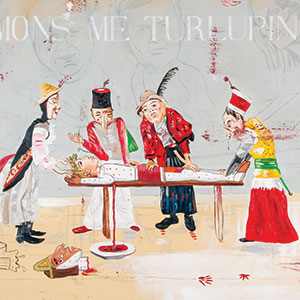Arts
Written Word
 SNEAKY DEVILS: 'Thinking of Ensor and My Cat Diego/Pensando en Ensor y mi gato Diego,' a 2009 painting by Enrique Chagoya.
SNEAKY DEVILS: 'Thinking of Ensor and My Cat Diego/Pensando en Ensor y mi gato Diego,' a 2009 painting by Enrique Chagoya.
It's not a bird. It's not a plane. And it's definitely not Superman. But on the right side of Enrique Chagoya's canvas, you can make out part of the Man of Steel's familiar logo. SUPER is spelled out in the familiar block lettering but the word is reversed (REPUS) and falling off the chest of a Frankenstein-like figure.
The face doesn't belong to Kal-El, the comic-book alien sent to Earth from Krypton. It's a jumble of seven or eight faces collaged together. Supergirl's cape is flying freely behind her back but the logo covers her face and upper torso. Superman himself does make an appearance. He's flying straight into the "S" but you can only catch a glimpse of one full leg and both of his red ankle boots as they disappear upwards.
In this acrylic and oil painting, The Ongoing Escape from Fantasylandia/El continuo escape de Fantasilandia (2013), the artist debunks the myth that the United States is a melting pot.
"That's why you see a mishmash of comic characters," Chagoya says. "These cultures are not integrated, unfortunately."
The longstanding dream was that immigrants from different countries could coexist peacefully. With this administration, in particular, Chagoya's deconstruction of an American hero suggests that the dream has become a nightmare.
"I believe that everybody is an alien," Chagoya writes in his summary of "Aliens," a solo exhibition at the Triton Museum of Art (through April 19). "I think that we all come from somewhere else. Nobody is pure ethnically."
This "concept," as he describes it, recurs in every vibrant canvas. Early in his career, Chagoya worked as an illustrator and graphic designer. From a distance, many of his paintings look like subversive ads or political cartoons. But the "ads" aren't coaching the viewer to become a better consumer. And, while his liberal approach to politics is clear, the messages contain multiple meanings that transcend typical cartoon punchlines.
Chagoya incorporates text, often as headlines, in nearly every painting. But the text isn't meant to comment on the images and the images aren't illustrating the text.
"It's more like a duet," he explains. "Maybe a violin is going in one direction and then a flute is going in a totally different direction, but they have the same rhythm. That makes a really interesting counterpoint in music."
The Ongoing Escape includes "the thingness of the thing" in white stenciled letters. This headline is speaking to a different part of the brain than the image of a disrupted Superman. The connection between the phrase "Démons Me Turlupinant" and the imagery in Thinking of Ensor and My Cat Diego/Pensando en Ensor y mi gato Diego (2009) is somewhat less obscure.
In the center of the canvas, "Démons Me Turlupinant" (Demons Tormenting Me) floats on a gray wall across the ghostly faces of Bill O'Reilly, Lou Dobbs, Rush Limbaugh and Ann Coulter. Chagoya repurposes James Ensor's painting The Assassination (1890) into Thinking of Ensor as a commentary on "a contemporary social issue." In the updated version, the patient on the table is a "pre-Colombian indigenous character whose head has been cut off and replaced by a European head." The new head's been reattached so that it's more acceptable to the ultra-conservatives haunting the room.
Chagoya takes a slyer approach with the text addenda in Illegal Alien's Guide to the Theory of Surplus Value/Guía sobre la teoría de la plusvalía para extranjeros ilegales (2010). He does include the English half of this nautical painting's title. But a voice from his id pops out of the ocean. He inserts a truck on pontoons into the lower left corner and draws in a minute non sequitur from the invisible driver inside. The artist also emblazons a series of names on the bows of passing ships (one's on fire, another one's sinking). Each name is part of a sentence when the canvas is read from left to right, as if it were a page in a book: "Part of the charm is the elusiveness of meaning."
This "duet" of text and imagery is resistant to one-note readings of Chagoya's work. Of course, immigration is the main theme that runs through most of the narratives. But the recurrence of monsters contorting themselves across primary-color schemes expresses something beyond reportage or documentary. Chagoya's meanings are elusive and allusive. The "thingness of his things" reflects back our shadow selves rather than our hoped-for, and idealized, dreams.
Aliens
Thru April 19, Free
Triton Museum of Art, Santa Clara
tritonmuseum.org


